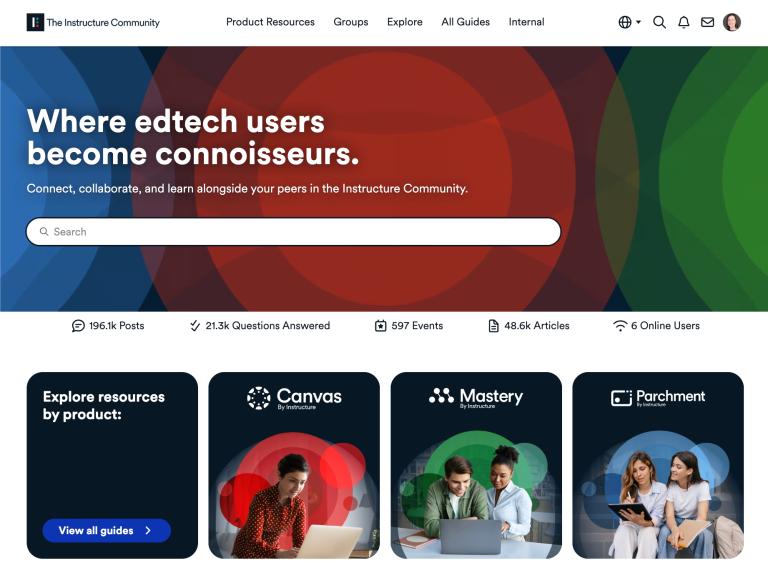Thank you to Erin Mills, PhD, Kaila Kea, and Gannon Nordberg from Lord Fairfax Community College (Becoming Laurel Ridge), a member of the Virginia Community College System, for this guest article.
Explore and Adapt
Issue
We live, teach, and learn in a multicultural world with people of varying backgrounds, so embracing diversity in the classroom is imperative to student success. Embracing diversity in the classroom starts with recognizing the full range of your students and their experiences as well as identifying proactive ways to celebrate diversity in your approach to teaching. At a glance, here are broad definitions of diversity, equity, inclusion, and belonging:
Diversity: “The collective mixture of differences and similarities that includes for example, individual and organizational characteristics, values, beliefs, experiences, backgrounds, preferences, and behaviors.” (SHRM)
Equity: fairness and justice; recognizing that we do not all start from the same place and must acknowledge and make adjustments to imbalances. (NACE)
Inclusion: practices in which different groups or individuals having different backgrounds are culturally and socially accepted and welcomed, and equally treated. (Global Diversity Practice)
Belonging: a human emotional need to affiliate with and be accepted by members of a group. (Verywell Mind)
Relevance
Students gain a more thorough understanding of the subject matter when presented with course content that reflects true diversity. While the traditional definition of diversity speaks to recognizing the differences across people of all races and ethnicities, it is so much more than that!
Diversity in the classroom includes:
- Showing respect for experiences that are different from your own.
- Acknowledging that discrimination creates privileges for some while creating disadvantages for others.
- Keeping an open mind toward new ideas and concepts.
- Recognizing the spectrum of differences between people, including race, gender, gender identity, sexual orientation, socioeconomic status, and physical ability, to name a few.
- Fostering student voice, which gives students a chance to develop autonomy over their own learning.
Student voice is central to diversity in the classroom because it is predicated on the idea that every student has something to contribute. Student voice includes any productive feedback students share about how to improve teaching and learning. As an instructor, you can champion student voice by giving students the chance to actively influence their education via surveys and group/one-on-one discussions. You can also start each class with an icebreaker during which students can discuss which assignments they identify with most/least and explain why or give students a choice for what assignment to complete for the final exam.
The fact that there is no “one size fits all” definition of diversity is fitting; after all, there is no one size fits all approach to teaching and learning, nor is there just one type of student. The definition varies just like your students and their experiences vary. Maintain flexibility in your teaching practices to accommodate your diverse student base, helping your students feel embraced and giving them the confidence (and comfort) to enrich your classroom with their own unique experiences, ideas, and perspectives.
Strategies
Before you were an instructor, you were a learner. Embracing diversity in the classroom gives you opportunities for continuous learning, so in many ways, you get to be a learner again! Dive into these strategies to see tangible ways that you can consistently and regularly embrace diversity in your classroom, whether online or in-person.
Strategy #1: Encourage all students to participate.
This may sound like an obvious one, but by motivating your students to participate in class discussions, you are inviting them to add their unique perspective to the overall conversation. Highlight your students’ individual contributions as key additions that create a better learning experience for everyone.
Strategy #2: Prioritize accessibility.
A diverse classroom often includes students with different abilities. Make sure that every aspect of your classroom (including course content) is accessible to all students. In their recent student technology report, Educause reported that mental health disorders and learning disabilities such as ADHD and dyslexia were among the leading disabilities students had. Of them, forty-four percent had not registered with their school’s disability services office. Another way you can prioritize accessibility is to make sure your students know how to register with the school’s disability office. Include specific instructions in your syllabus, invite a member of the disability office to your classroom to discuss the registration process, and make accessibility a part of your resounding efforts to embrace diversity.
Strategy #3: Choose inclusive imagery.
Representation is important. Students who can see depictions of themselves in your PowerPoint presentations, selected texts, and other visuals are more likely to connect with the course content. Make it a point to consistently use images and videos that feature people of color, nontraditional students, individuals with hearing, visual, and physical impairments, and other groups that are rarely represented.
Strategy #4: Avoid using stereotypes and generalizations in your course content.
In the same way you wouldn’t expect to speak for every instructor in the world, you shouldn’t expect every student to speak for other students. For example, if you have a student who speaks more than one language, you shouldn’t expect them to speak for every bilingual person. You also shouldn’t target them when a conversation about languages arises. Don’t assume they want to speak about a topic just because the topic appears to relate to them.
Inspire
Student voice has no age, color, size, or gender limitations. Successful integration of student voice in the classroom requires an environment built on mutual respect, trust, and responsibility.
Listen
Listening to students builds trust and is a demonstrable skill in the classroom. Engaged listening isn’t limited to just hearing what the student is saying, but requires a genuine interest in the student’s ideas, participation, and success.
Consider: In what ways do I gather students’ input and ideas during class time, how can I make sure all voices are heard and how will students know if I’m listening to them?
All students have something to share. Ask them about career aspirations or interests. Encourage students to share prior knowledge and provide opportunities for students to share learned experiences and perceptions.
But what if my students don’t readily participate?
Voice is a learned skill. Do not expect that all students will know how or feel comfortable sharing their ideas with the class. Demonstrate how to respectfully share and contribute toward class activities and discussions and also demonstrate ways to respond to differences in opinion.
Listening requires patience, and when done well is not rushed for time. In order for students to feel their contributions matter and are valued instructors must be very intentional in how they communicate with their students throughout the duration of the semester.
Communicate and Collaborate
When an instructor believes that students have something to contribute, they find ways to create opportunities to connect with students and understand their perspectives. Continually considering students’ ideas and views transforms listening into communication and collaboration.
Consider: How do I show the students their opinions and ideas matter? How do I ensure students are meaningfully involved in the course material? What type of opportunities do students have to make positive contributions to class activities, assignments, and discussions?
Involve all students. Develop strategies that encourage student feedback. Structure activities and assignments that teach students how to work collaboratively and listen to one another. Give students enough time to work, consider and respond to questions.
But how do introverted students share their voice?
Voice is not about being the loudest person in the room, introverts and extroverts should have varied and appropriate opportunities to share their voices such as small group discussions, low stakes writing, and unit reflection activities. Oftentimes the introverts in the class have a lot to say when it’s not vocalized in front of the class.
Communication and collaboration include accepting responsibility for what is said and what needs to be said during class time. These efforts can be strengthened when everyone expects contributions from others and willingly participates.
Reflect
Reflection is an integral part of a student's voice. Meaningful reflection requires introspection on personal contributions to the class activities, analyzing how well they contributed and collaborated, and identifying areas for improvement.
Consider: What was the outcome of the student’s participation in class today? How am I actively responding to student participation and encouraging them to reflect on their participation? How can the students and I work together to foster student voice every week?
Develop student responsibility for learning through frequent reflection activities. Provide time for students to think about how they clarified their learning, showed others they valued their opinions and expressed their thoughts and opinions. Be prepared to celebrate participation and work through challenging areas.
How do I create time for voice and reflection in my class?
Create opportunities for all students to actively participate, and seek student feedback to gauge when their voices are not being heard. Rather than setting aside time in the class schedule for student voice, build it into the course design so it becomes synonymous with your class materials and activities.
Reflection is an ongoing process. Mutual trust and respect for our students is a key component to building a classroom environment that values students’ voices. Actively listen to what students share. Be approachable and demonstrate respect for all contributions.
Student voice includes embracing students’ opinions and ideas; everyone has something to contribute. As instructors, we need to be willing to listen, communicate, collaborate and reflect together. Genuinely developing student voice in the classroom leads to active participation, increased student engagement, and an environment built on trust and respect.
Additional Resources
- Achieving Equity with Canvas LMS
- 5 Tips for the Empathetic Classroom
- There is No Achievement Gap at Birth. Dr. Knatokie Ford's InstructureCon Keynote
- 4 Ways to Tackle the Barriers to Remote Learning
- Our Survey Says: Access to Technology and Mental Health Resources Impact Student Engagement
- Mobility and Accessibility: The Canvas Mobile App
- Mobile Learning, To the Power of Canvas
To learn more about how Canvas LMS assists with embracing diversity in the classroom, check out our resources on The Study Hall or book a demo.
Related Content
 inst-3step.jpg
inst-3step.jpgBlogs
 13lmsfeaturesthatbenefitstudentlearning.jpg
13lmsfeaturesthatbenefitstudentlearning.jpgBlogs
 community-homepage.jpg
community-homepage.jpgBlogs
